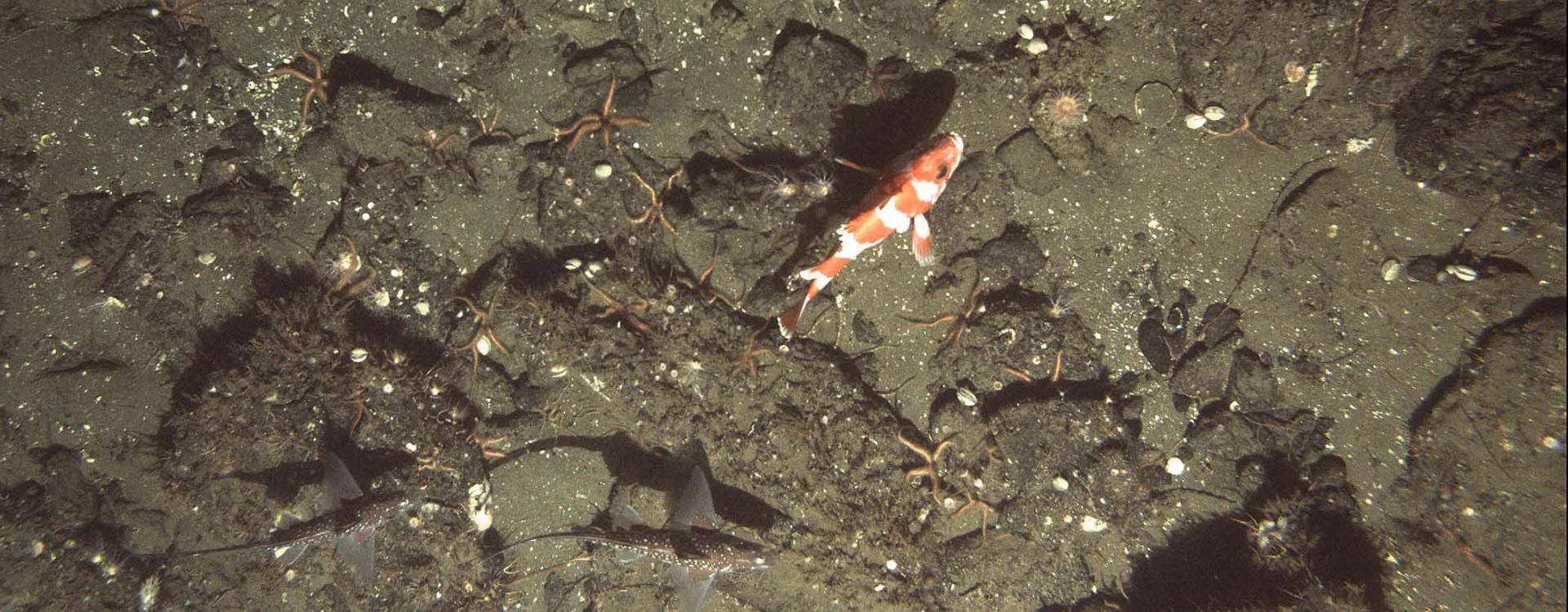
Flag rockfish on asphalt seafloor. Photo Credit: Love et Al.
Santa Barbara Channel’s natural oil seeps are a beach-goer’s bane, flecking the shores with blobs of tar. But the leaking petroleum also creates fascinating geologic and biologic features. About 10 miles off the coast of Santa Barbara, several jet-black mounds interrupt the featureless sea floor. These asphalt volcanoes, virtually unique in the world, provide a rare habitat in a region known for its underwater biodiversity.
Marine scientists have compiled the first detailed description of the animal communities that call these formations home. The findings, published in the Bulletin of Marine Science, detail the different kinds of fishes that live on and around the volcanoes.
These vents erupt hot tar instead of lava, slowly building up smooth mounds that can be several dozen feet tall. In 2010, a team led by UC Santa Barbara Professor Dave Valentine documented two volcanoes in the Santa Barbara Channel, which they named Il Duomo and Il Duomito. The group published an account of the geology and characterized the habitat.
“Even in our channel, that has lots of seeps, there’s only two asphalt volcanoes that we know of,” said lead author Milton Love, a researcher at UC Santa Barbara’s Marine Science Institute. “So it takes an almost unique set of circumstances to form these.”
Yet, virtually nothing was known about the animals living at asphalt volcanoes aside from a brief description Valentine and his co-authors provided in their 2010 paper. So, Love and his colleagues used footage from an autonomous underwater vehicle to characterize the fish communities that inhabit these remarkable features. Their goal was to figure out who lives where and why. The team combed through eight hours of surveys — encompassing 2,743 still images — gradually building up a roster of the neighborhood.
Although fish densities were low, the team found a relatively diverse assemblage of species. Altogether, they observed 1,836 fish representing no less than 43 species. And at least 53.5% of these species were rockfishes. “This is what you would expect to find if you surveyed a tall and fairly smooth rock reef in this location,” Love said.
Certain fish preferred the volcanoes’ uniform slopes, meanwhile, a variety of poachers and flatfishes populated the muddy sea bottom surrounding the mounds. Oddly enough, there were haloes several meters wide around the volcanoes devoid of flatfishes. Love suspects those fish that ventured too close were spotted against the black tar and eaten.
The researchers observed a few taxa that moved between the mud and the edges of the asphalt, such as shortspine combfish, greenstriped rockfish and spotted ratfish. Notably rare were the “sheltering guild” of fishes, such as bocaccio and cowcod, which require nooks and crannies that are absent on the asphalt volcanoes’ smooth slopes, as well as the surrounding sea floor. However, “Even small amounts of asphalt in an image had a substantial effect on the species that were observed,” the authors wrote, as soft-seafloor fishes kept away from the hard tar.
Although dormant now, the asphalt volcanoes are relatively new features. “They probably developed around 40,000 years ago,” Love said. And he was quick to point out that they were quite different just a few thousand years ago.
Today, the volcanoes have a stark beauty. Colorful invertebrates pop out in sharp relief against the black substrate. “You have all kinds of sponges and deep-water corals,” Love said. The group hopes to publish an account of the invertebrate assemblages in the future.
Unfortunately, the team also found evidence of illegal fishing, including lost lines, weights and even a rockfish carcass still on the hook. Although the fish communities are typical of the area, Love believes California should protect these sites given how unique they are. “Not only are there only three places known that have this habitat, but this is the only one in shallow water,” he said.
More Coverage
Asphalt Volcanoes Under the Santa Barbara Channel
Santa Barbara Independent, February 25, 2023, 10:03 AM